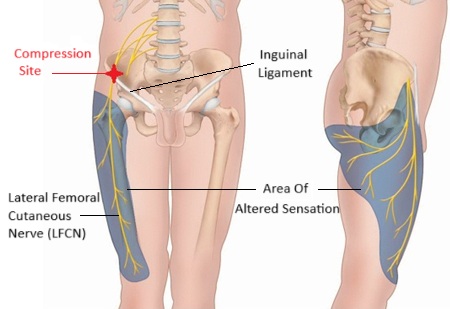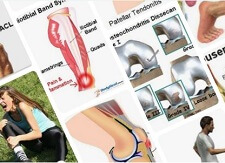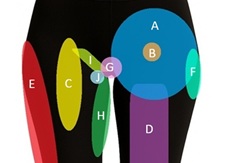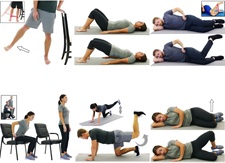- Home
- Hip Pain Diagnosis
- Meralgia Paraesthetica
Meralgia Paresthetica
Written By: Chloe Wilson, BSc(Hons) Physiotherapy
Reviewed by: KPE Medical Review Board

Meralgia paresthetica is a nerve problem which causes pain, tingling and numbness in the outer thigh.
It is caused by compression in one of the nerves as it passes across the front of the hip and down the thigh.
Common causes include wearing tight clothing, hip injuries and previous hip surgery.
Unlike other nerve injuries, meralgia paresthetica only affects the sensation in the thigh, muscle strength and leg movements are unaffected.
Meralgia paresthetica can be quite unpleasant but it is generally not serious, and responds well to home treatments.
What Is Meralgia Paresthetica?

Meralgia paresthetica is a type of nerve entrapment syndrome where one of the thigh nerves is squashed or irritated.
The nerve involved is the lateral femoral cutaneous nerve (LFCN).
It branches out from the back of the lower spine (L2 & L3) and passes across the front of the hip, underneath the inguinal ligament.
The lateral femoral cutaneous nerve is responsible for providing sensation to the surface of the skin on the front and outer side of your thigh, down to the knee. Pressure on the nerve causes numbness, tingling, burning, or stabbing pain on the outer part of the thigh.
It is solely a sensory nerve, not a motor nerve, so it doesn't control any of the leg muscles, meaning strength and movement are unaffected.
Meralgia paresthetica is also known as Bernhardt Roth syndrome, lateral femoral cutaneous neuralgia or lateral femoral cutaneous nerve syndrome. It is one of the less common causes of upper thigh pain.
What Causes Meralgia Paresthetica?
Meralgia paresthetica occurs when the lateral femoral cutaneous nerve is compressed, typically as it passes under the inguinal ligament near the groin. Common meralgia paresthetica causes include:
- Tight Clothing: such as belts, corsets, or skinny jeans
- Heavy Work Belts: worn by tradesmen to hold their tools
- Prolonged Standing Or Walking: which can lead to irritation of the nerve over time
- Leg Length Discrepancy: having one leg longer than the other can place increased pressure on the nerve
- Trauma Or Surgery: previous hip surgeries e.g. hernia repair or hip replacement, seat belt injuries from car accidents, or sports injuries can cause scar tissue to form near or around the nerve
- Tumor: a benign lump (non-cancerous) known as a neuroma may develop near the nerve, causing compression. Occasionally there may be a cancerous tumor although this is rare.
Other rare causes of Bernhardt Roth syndrome include lead poisoning and pubic symphysis defects, and there is an increased risk if you have carpal tunnel syndrome.
Meralgia paresthetica can affect people at any age but is most common in people aged 40-60. It is more prevalent in women than men.
Risk Factors
Certain factors increase your likelihood of developing meralgia paresthetica:
- Obesity Or Weight Gain: excess fat can increase pressure on the nerve
- Pregnancy: hormonal changes and weight gain can contribute to nerve compression
- Diabetes: nerve damage associated with diabetes may increase the risk
Meralgia Paresthetica Symptoms
Common meralgia paresthetica symptoms include:
- Burning or aching pain on the outer thigh which may extend to the knee
- Tingling or numbness in the same area
- Increased sensitivity to light touch and pressure
- Symptoms often worsen with standing or walking and improve with sitting
Bernhardt Roth syndrome typically affects only one side of the body and there is no muscle weakness or pain radiating below the knee.
Bernhardt Roth Syndrome Diagnosis
Doctors usually diagnose meralgia paresthetica based on your symptoms and physical exam. They may also:
- Ask about your medical history and lifestyle habits
- Perform a sensory exam to test feeling in your thigh: including light touch and pin prick testing
- Perform the pelvic compression test. Lying on your unaffected side, the doctor applies downward pressure through your pelvis/ilium for 45 seconds. If symptoms decrease, it indicates meralgia paresthetica.
- Order imaging tests (MRI, X-ray, Ultrasound) to rule out other conditions
- Use nerve conduction studies to assess how well the LFCN is working
- Inject a local anesthetic near the nerve to see if it relieves symptoms
- Blood tests may be ordered to check thyroid, glucose and vitamin B levels, or to rule out lead poisoning
Hip and back movements, muscle power and deep tendon reflex testing will all be normal with meralgia paresthetica.
When to See a Doctor
You should seek medical advice if:
- Symptoms last longer than a few weeks
- The pain becomes severe or disabling
- Numbness or tingling spreads beyond the thigh or into the saddle area
- There are any changes in your bladder or bowel control
Treatment For Meralgia Paresthetica
In most cases symptoms will improve with conservative meralgia paresthetica treatment such as:
- Lifestyle Modifications:
avoiding tight clothing, losing excess weight and changing standing or walking
habits are often effective for meralgia paresthetica treatment at home
- Medications: NSAIDs for
pain relief, and nerve pain medications like gabapentin or amitriptyline help
to reduce Bernhardt Roth syndrome symptoms – talk to your doctor before
starting any new medication
- Physical Therapy: a
physical therapist can advise on meralgia paresthetica exercises and posture
correction and may use kinesio-taping to off-load the nerve or acupuncture to
reduce pain. Meralgia paresthetica exercises usually consist of:
Strengthening Exercises: focus on glute strengthening to improve strength, stability and control
Meralgia Paresthetica Stretches: such as hip flexor stretches and quad stretches
- Nerve Blocks:
corticosteroid or anesthetic injections to reduce nerve inflammation and pain
- Surgery: in rare, severe cases where symptoms don’t improve, nerve decompression or resection (neurectomy) may be considered

Recovery
Recovery times from meralgia paresthetica vary but the prognosis is good, with around 85% of people making a full recovery without the need for surgical intervention. Some people feel better in a few weeks, while others may take several months, and in some cases there may be some mild ongoing altered sensation long-term.
For those who need surgery, recovery usually takes around 3 months. And for people with meralgia paresthetica in pregnancy, symptoms usually stop once you have delivered.
With proper treatment and avoidance of aggravating factors, most people experience significant improvement or complete resolution of meralgia paresthetica symptoms.
Frequently Asked
Questions (FAQs)
What Is the Best Meralgia Paresthetica Sleeping Position?
What Is the Best Meralgia Paresthetica Sleeping Position?
Sleeping on your back with a pillow under your knees is usually best with meralgia paresthetica. If you prefer side sleeping, lie on the unaffected side with a pillow between your knees to reduce pressure on the affected nerve.
Is Meralgia Paresthetica Dangerous?
Is Meralgia Paresthetica Dangerous?
Meralgia paresthetica is not life-threatening and doesn’t affect muscles or motor control. However, it can cause chronic discomfort and impact quality of life if left untreated. But 85% of cases fully resolve with simple treatment.
Why Can You Get Meralgia
Paresthetica in Pregnancy?
Why Can You Get Meralgia Paresthetica in Pregnancy?
Pregnancy can lead to Bernhardt Roth syndrome due to weight gain, postural changes, and increased pressure on the inguinal ligament where the nerve passes. This irritates and compresses the nerve causing altered sensation. Symptoms typically resolve quickly once your baby is born.
What Is the Meralgia
Paresthetica ICD 10?
What Is the Meralgia Paresthetica ICD 10?
The ICD-10 code for meralgia paresthetica is G57.1.
What Is the Best Meralgia
Paresthetica Medication?
What Is the Best Meralgia Paresthetica Medication?
The best medications for Bernhardt Roth syndrome include non-steroidal anti-inflammatory drugs (NSAIDs) for pain and nerve medications like gabapentin or amitriptyline for nerve-related symptoms.
Can
Meralgia Paresthetica Be Cured?
Can Meralgia Paresthetica Be Cured?
Yes, many cases of resolve with conservative treatment such as lifestyle changes, physical therapy, and medication. Persistent cases may require nerve blocks or surgery.
Does Meralgia
Paresthetica Affect Both Sides?
Does Meralgia Paresthetica Affect Both Sides?
It typically affects only one side of the body, but in rare cases, it can be bilateral, especially if the underlying cause affects both sides of the pelvis.
Meralgia Paresthetica
Summary
Meralgia paresthetica is a nerve compression condition that causes pain, numbness, or tingling on the outer thigh. It is often caused by pressure on the lateral femoral cutaneous nerve from tight clothing, obesity, or prolonged activity. It is also known as Bernhardt Roth syndrome or lateral femoral cutaneous neuralgia.
Diagnosis of meralgia paresthetica is typically straightforward, and most cases respond well to lifestyle changes, physical therapy, and medications. If symptoms persist, more advanced interventions like nerve blocks or surgery may be necessary. Early recognition and treatment are key to a smooth recovery.
You may also be interested in the following articles:
- Pain Above The Knee
- Upper Thigh Pain
- Outer Hip Pain
- Inner Thigh Pain
- Hip Bursitis
- Hip Labral Tear
- Burning Knee Pain
Related Articles
Knee Pain Diagnosis
March 27, 2025
Hip Pain Diagnosis
September 16, 2025
Hip Strengthening
September 24, 2025
Medical & Scientific References
- Meralgia Paresthetica. National Library Of Medicine
- Meralgia Paresthetica: A Review Of The Literature. International Journal Of Sports Physical Therapy
- Meralgia Paresthetica: A result of tight new trendy low cut trousers (‘taille basse’). International Journal Of Surgery
- Meralgia Paraesthetica. Radiopaedia
Last Updated: August 30th, 2025
Next Review Due: August 30th, 2027





